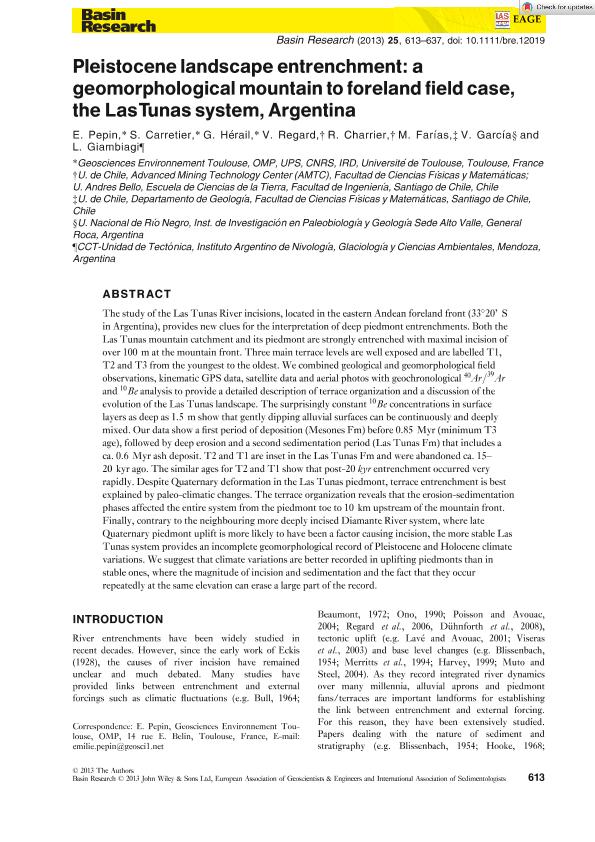Artículo
Pleistocene landscape entrenchment: a geomorphological mountain to foreland field case, the Las Tunas system, Argentina
Fecha de publicación:
25/05/2013
Editorial:
Wiley Blackwell Publishing, Inc
Revista:
Basin Research
ISSN:
0950-091X
Idioma:
Inglés
Tipo de recurso:
Artículo publicado
Clasificación temática:
Resumen
The study of the Las Tunas River incisions, located in the eastern Andean foreland front (3320’ S in Argentina), provides new clues for the interpretation of deep piedmont entrenchments. Both the Las Tunas mountain catchment and its piedmont are strongly entrenched with maximal incision of over 100 m at the mountain front. Three main terrace levels are well exposed and are labelled T1, T2 and T3 from the youngest to the oldest. We combined geological and geomorphological field observations, kinematic GPS data, satellite data and aerial photos with geochronological 40 Ar/39 Ar and 10 Be analysis to provide a detailed description of terrace organization and a discussion of the evolution of the Las Tunas landscape. The surprisingly 10 Be constant concentrations in surface layers as deep as 1.5 m show that gently dipping alluvial surfaces can be continuously and deeply mixed. Our data show a first period of deposition (Mesones Fm) before 0.85 Myr (minimum T3 age), followed by deep erosion and a second sedimentation period (Las Tunas Fm) that includes a ca. 0.6 Myr ash deposit. T2 and T1 are inset in the Las Tunas Fm and were abandoned ca. 15–20 kyr ago. The similar ages for T2 and T1 show that post-20kyr entrenchment occurred very rapidly. Despite Quaternary deformation in the Las Tunas piedmont, terrace entrenchment is best explained by paleo-climatic changes. The terrace organization reveals that the erosion-sedimentation phases affected the entire system from the piedmont toe to 10 km upstream of the mountain front. Finally, contrary to the neighbouring more deeply incised Diamante River system, where late Quaternary piedmont uplift is more likely to have been a factor causing incision, the more stable Las Tunas system provides an incomplete geomorphological record of Pleistocene and Holocene climate variations. We suggest that climate variations are better recorded in uplifting piedmonts than in stable ones, where the magnitude of incision and sedimentation and the fact that they occur repeatedly at the same elevation can erase a large part of the record.
Palabras clave:
Andes
,
Mountain -Fan System
,
Geochronology
,
Erosion
Archivos asociados
Licencia
Identificadores
Colecciones
Articulos(IANIGLA)
Articulos de INST. ARG. DE NIVOLOGIA, GLACIOLOGIA Y CS. AMBIENT
Articulos de INST. ARG. DE NIVOLOGIA, GLACIOLOGIA Y CS. AMBIENT
Citación
Pepin, E.; Carrieter, S.; Hérail, G.; Regard, V.; Charrier, R. ; et al.; Pleistocene landscape entrenchment: a geomorphological mountain to foreland field case, the Las Tunas system, Argentina; Wiley Blackwell Publishing, Inc; Basin Research; 25; 6; 25-5-2013; 613-637
Compartir
Altmétricas




